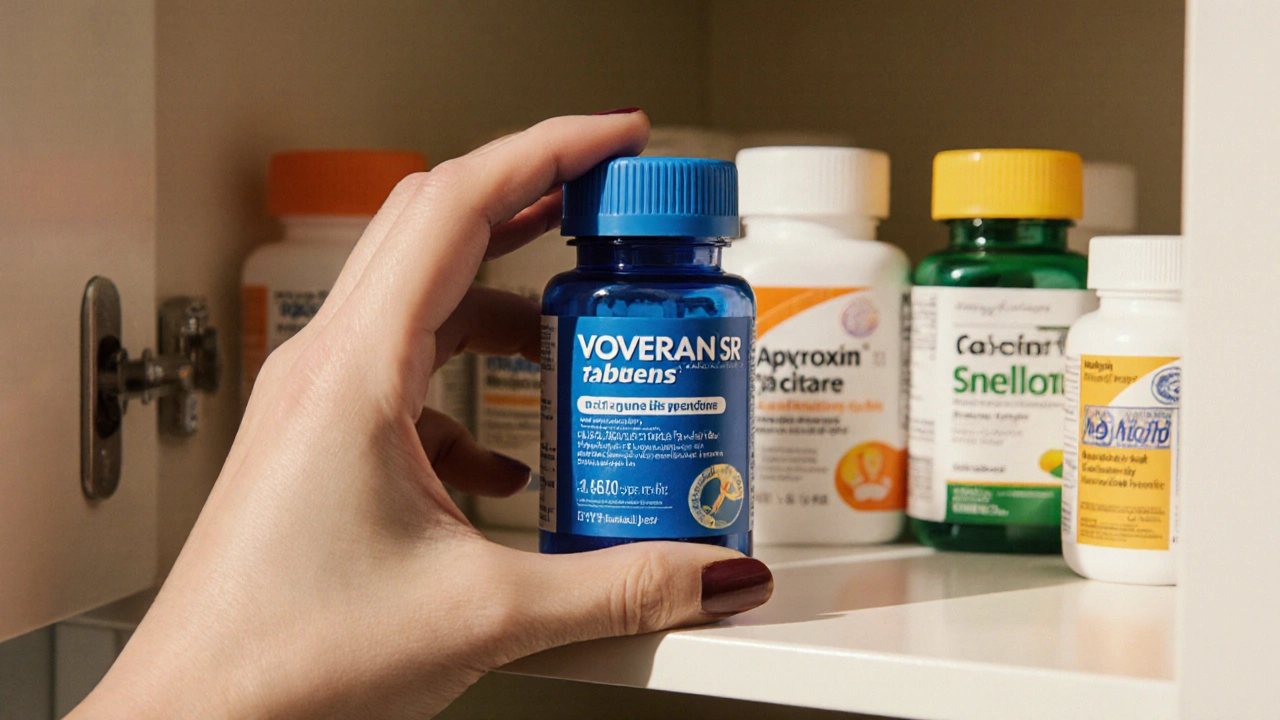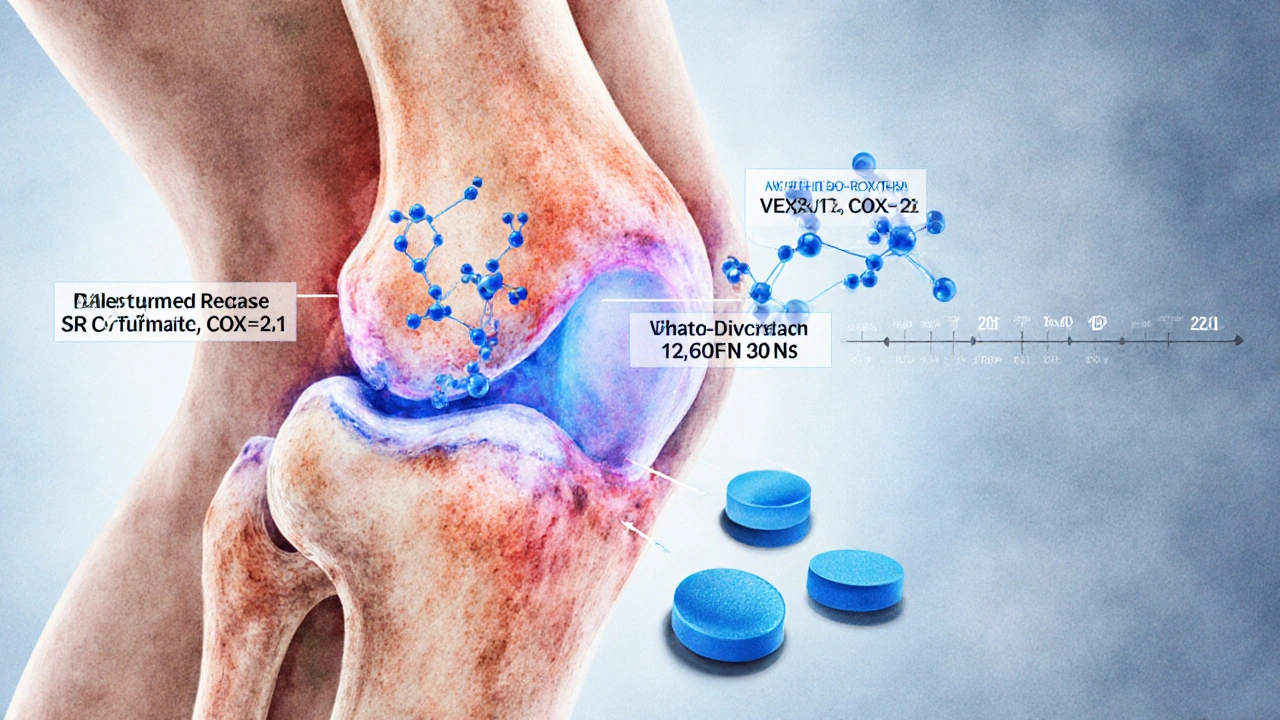
When you reach for a pill to knock out back pain or a swollen joint, you want something that works fast, costs reasonable, and doesn’t land you in the ER. Voveran SR is a brand‑name formulation of diclofenac, a potent non‑steroidal anti‑inflammatory drug (NSAID) designed for sustained release. The question on many Canadians' minds is whether that drug is the best fit or if a cheaper, safer, or more convenient alternative would do the job.
Key Takeaways
- Voveran SR delivers consistent pain relief for up to 12hours, but it carries higher gastrointestinal and cardiovascular risks than many over‑the‑counter options.
- Ibuprofen and naproxen are solid OTC choices for mild‑to‑moderate pain with a more forgiving safety profile.
- Celecoxib (a selective COX‑2 inhibitor) can be gentler on the stomach but may raise heart‑related concerns for some users.
- Acetaminophen (paracetamol) provides pain relief without anti‑inflammatory action; it’s safest for liver‑sensitive patients when dosed correctly.
- Choosing the right drug hinges on the condition you’re treating, existing health issues, prescription status, and cost considerations.
What Is Voveran SR?
Voveran SR is a sustained‑release tablet containing 50mg of diclofenac sodium. It is typically prescribed for chronic inflammatory conditions such as rheumatoid arthritis, osteoarthritis, and ankylosing spondylitis. Because the tablet slowly releases the active ingredient over 12hours, patients often take it once or twice daily, which can improve adherence for long‑term therapy.
Key attributes of Voveran SR:
- Formulation: Extended‑release tablet
- Typical dose: 50mg once or twice daily
- Prescription status: Canada - prescription‑only
- Primary action: Inhibits COX‑1 and COX‑2 enzymes, reducing prostaglandin synthesis and thus inflammation and pain
How NSAIDs Work - A Quick Primer
All NSAIDs-including Voveran SR-target cyclo‑oxygenase enzymes (COX‑1 and COX‑2). By blocking these enzymes, they lower prostaglandin levels, which are the chemicals that cause pain, fever, and swelling. The difference between drugs lies in how strongly they block each enzyme, how long they stay in the bloodstream, and the extra ingredients they might contain.
Common Alternatives to Voveran SR
Below are the most frequently‑used pain‑relief options that people compare against Voveran SR.
- Ibuprofen an OTC NSAID available in 200mg and 400mg tablets
- Naproxen a longer‑acting OTC NSAID, often sold as 220mg tablets (Aleve)
- Celecoxib a prescription‑only selective COX‑2 inhibitor, marketed as 100mg capsules
- Acetaminophen also known as paracetamol, an analgesic without anti‑inflammatory properties
Decision Criteria - What to Compare
When weighing Voveran SR against the alternatives, look at six practical factors:
- Efficacy for your condition - Does the drug reduce inflammation enough for arthritis, or just dull the pain?
- Duration of action - How many doses per day will you need?
- Prescription requirement - Can you buy it off the shelf or do you need a doctor’s note?
- Side‑effect profile - Gastrointestinal bleeding, heart risk, kidney strain, liver concerns?
- Cost & insurance coverage - Out‑of‑pocket price versus generic equivalents?
- Drug interactions - Does it clash with blood thinners, antihypertensives, or diabetes meds?

Side‑Effect Snapshot
All NSAIDs share a baseline risk for stomach irritation, but the magnitude varies.
| Medication | GI Bleeding | Cardiovascular Risk | Kidney Impact |
|---|---|---|---|
| Voveran SR (Diclofenac) | High (especially with long‑term use) | Elevated - linked to increased heart attack risk | Moderate - monitor renal function |
| Ibuprofen | Medium | Low‑to‑moderate (dose‑dependent) | Low‑to‑moderate |
| Naproxen | Medium | Low - often preferred for heart‑risk patients | Low‑to‑moderate |
| Celecoxib | Low (COX‑2 selective) | Higher for patients with existing heart disease | Low |
| Acetaminophen | None | None | Potential liver toxicity at >4g/day |
Cost Overview (2025 Canada)
Price matters, especially if you need a medication for months or years.
- Voveran SR - roughly CAD0.75 per 50mg tablet (often covered by provincial formularies for seniors).
- Ibuprofen - OTC, about CAD0.15 per 200mg tablet.
- Naproxen - OTC, CAD0.20 per 220mg tablet.
- Celecoxib - prescription, CAD1.20 per 100mg capsule (generics may be cheaper).
- Acetaminophen - OTC, CAD0.10 per 500mg tablet.
If you have extended drug coverage, Voveran SR’s higher price can be offset, but for those paying out‑of‑pocket, ibuprofen or naproxen are clearly budget‑friendly.
Best‑Fit Scenarios
Here’s a quick guide on when each drug shines.
| Medication | Most Effective For | When to Prefer Alternative |
|---|---|---|
| Voveran SR | Severe chronic inflammatory arthritis needing steady 12‑hour coverage | History of ulcers, heart disease, or need for OTC access |
| Ibuprofen | Mild‑to‑moderate acute pain (backache, dental pain) | Long‑term daily use or high cardiovascular risk |
| Naproxen | Inflammatory pain where dosing only twice daily is convenient | Patients with uncontrolled hypertension |
| Celecoxib | Patients needing anti‑inflammatory effect but who cannot tolerate stomach irritation | Those with known coronary artery disease or on anticoagulants |
| Acetaminophen | Fever or pain without inflammation, especially in liver‑stable adults | Severe inflammatory conditions where NSAIDs are required |
Pros and Cons of Voveran SR
Pros
- Consistent 12‑hour pain control reduces dosing frequency.
- Strong anti‑inflammatory effect makes it ideal for joint degeneration.
- Prescription status means dosage is monitored by a healthcare professional.
Cons
- Higher risk of stomach ulcers and bleeding, especially when combined with alcohol or steroids.
- Linked to increased heart attack and stroke risk in patients over 60.
- More expensive than OTC NSAIDs and may not be fully covered by private insurance.

Tips for Safe Use
Even if you choose Voveran SR, these habits can keep you out of trouble.
- Take the tablet with food or a full glass of milk to buffer the stomach.
- Never exceed the prescribed dose; the extended‑release design is meant for once/twice‑daily use only.
- If you also need blood thinners, discuss timing with your doctor - stagger the doses by at least 4hours.
- Schedule a yearly check‑up for liver and kidney function tests.
- Consider a proton‑pump inhibitor (e.g., omeprazole) if you have a past ulcer history.
When an Alternative Might Be Smarter
If any of these apply, you might look elsewhere:
- You have a history of peptic ulcers or are on chronic steroids.
- You’ve been diagnosed with hypertension, atrial fibrillation, or recent heart surgery.
- You’re on dialysis or have chronic kidney disease stage3 or higher.
- You need a medication you can buy without a prescription while traveling.
In those cases, ibuprofen, naproxen, or acetaminophen often provide sufficient relief with a cleaner safety profile.
Frequently Asked Questions
Can I take Voveran SR with ibuprofen for extra pain control?
Mixing two NSAIDs increases the risk of stomach bleeding and kidney injury. Doctors usually advise against it unless they closely monitor the patient.
How does Voveran SR differ from regular diclofenac tablets?
Regular diclofenac releases the drug within an hour, so you may need to take it 3‑4 times a day. Voveran SR’s extended‑release matrix spreads the dose over 12hours, cutting the dosing frequency in half.
Is Voveran SR safe for seniors over 75?
Seniors face higher GI and cardiovascular risks. If a doctor still prescribes Voveran SR, they’ll likely pair it with a gastro‑protective drug and schedule regular heart monitoring.
What should I do if I miss a Voveran SR dose?
Take the missed tablet as soon as you remember, unless it’s almost time for the next dose. In that case, skip the missed one and continue with the regular schedule; don’t double‑dose.
Can I use Voveran SR while pregnant?
Diclofenac is generally avoided during pregnancy, especially in the third trimester, because it can affect fetal blood flow. Talk to your obstetrician about safer options.
Next Steps for You
1. List any existing health conditions (heart, stomach, kidney, liver).
2. Write down the pain type you’re treating (acute injury vs. chronic arthritis).
3. Compare the cost and insurance coverage of Voveran SR versus the OTC alternatives you can buy at your local pharmacy.
4. Bring this info to your family doctor; they can help you weigh the GI versus cardiovascular risks and decide if the extended‑release diclofenac is worth it for you.
Remember, the “best” pain reliever isn’t a one‑size‑fits‑all label - it’s the one that matches your health profile, budget, and pain severity while keeping side effects at bay.





14 Comments
Hey folks 😊, I totally get why everyone’s looking at Voveran SR – a solid 12‑hour shoulder for chronic pain can feel like a lifesaver, especially when you’re juggling a busy schedule and need something that doesn’t demand constant refills. 🤗 In my experience, pairing it with a probiotic and a simple PPI can really tame the stomach side‑effects, making the whole package feel a lot friendlier. Just remember to have your doc keep an eye on your heart health, because the cardio risk is real, even if the pain relief feels amazing.
Let us consider the pharmacodynamics, the half‑life, the COX‑1 versus COX‑2 inhibition profile, and the broader therapeutic index-each of these factors contributes to the overall efficacy, safety, and patient adherence; consequently, the selection of Voveran SR over an OTC alternative must be guided by a comprehensive risk‑benefit analysis, especially given the heightened gastrointestinal and cardiovascular risk profile associated with diclofenac; moreover, the cost differential, while not trivial, may be offset by insurance coverage, yet the out‑of‑pocket expense can still be a barrier for many patients; therefore, a nuanced discussion with a healthcare professional is indispensable, and one must not overlook the importance of concurrent gastro‑protective strategies, such as the use of PPIs or H2 blockers, which are often recommended in clinical guidelines; finally, the extended‑release formulation offers the convenience of once‑ or twice‑daily dosing, potentially improving compliance, but it simultaneously imposes a sustained exposure that could amplify systemic adverse events if not monitored correctly.
Friends, it really comes down to listening to your own body and the gentle whisper of balance; Voveran SR can be a powerful ally when inflammation runs deep, yet the softer path of ibuprofen or naproxen may suit those who cherish a lighter touch on the stomach and heart. 🌱 Choose wisely, stay hopeful, and remember that health is a journey, not a race.
Think of pain management as a marathon, not a sprint; a steady, thoughtful approach-like the 12‑hour rhythm of Voveran SR-can keep you moving forward, but never ignore the signs your body sends about upset stomachs or a racing heart. Stay motivated, stay aware, and keep the conversation open with your clinician.
Bill makes a solid point, but I’d still say the price tag matters.
Rajesh, thanks for the balanced view 😊. Just a quick tip: if you’re on Voveran SR, adding a low‑dose omeprazole can really protect the gut without adding too many pills.
Totally agree with Tom-cost is key.
Well, if you’re going to spend extra on a brand‑name, you better be sure it’s actually better than the cheap generics, otherwise it’s just a marketing gimmick.
Look, Canadians need to stop letting foreign drug firms dictate our pain meds. Voveran SR is just another overpriced foreign product that puts our hearts at risk while lining their pockets. We deserve home‑grown, safer options that don’t come with hidden cardiovascular warnings.
The pharmacological landscape here is a veritable tapestry of COX inhibition, where diclofenac’s promiscuous affinity for both COX‑1 and COX‑2 creates a paradoxical tableau of analgesic potency juxtaposed against a crescendo of gastrointestinal peril; nevertheless, the nuanced interplay of dosage timing, patient comorbidities, and adjunctive gastro‑protective agents renders the therapeutic equation both intricate and compelling.
Enough with the sugar‑coated talk-if you’re not a patriot, you’ll just keep swallowing foreign pills that jeopardize our nation’s health. Voveran SR is a prime example of a drug that should be scrutinized, not blindly accepted.
It’s great to see the discussion turning toward real‑world considerations; remember, the best choice often comes down to personal health history and what your doctor thinks is safest for you.
Voveran SR works, but watch your stomach!
When evaluating Voveran SR, it is essential to first acknowledge the pharmacokinetic advantage conferred by its sustained‑release matrix, which permits a once‑or‑twice‑daily dosing schedule that aligns well with patient adherence patterns; second, the drug’s robust inhibition of both COX‑1 and COX‑2 enzymes provides a potent anti‑inflammatory effect that can be particularly beneficial for individuals suffering from chronic arthritic conditions; third, this very potency is a double‑edged sword, as the heightened COX‑1 inhibition elevates the risk for gastrointestinal bleeding, a concern that must be mitigated through concurrent gastro‑protective therapy or careful monitoring; fourth, cardiovascular risk must not be underestimated, especially in patients over the age of sixty who possess pre‑existing heart disease, since diclofenac has been associated with an increased incidence of myocardial infarction and stroke; fifth, the cost factor, while higher than generic OTC alternatives, may be offset by insurance coverage or provincial formularies for seniors, yet for uninsured patients the expense can be prohibitive; sixth, drug‑drug interactions remain a critical consideration, particularly with anticoagulants, antihypertensives, and certain antidepressants, necessitating a thorough medication review prior to initiation; seventh, renal function monitoring is advisable because sustained NSAID exposure can impair kidney performance, especially in dehydrated individuals or those with pre‑existing renal insufficiency; eighth, patient education plays a pivotal role-ensuring that individuals understand the importance of taking the medication with food or milk can reduce gastric irritation; ninth, the availability of generic diclofenac formulations may offer a more affordable yet comparable therapeutic option, though the release profile may differ; tenth, the decision to prescribe Voveran SR should be individualized, weighing the severity of inflammation, patient comorbidities, and lifestyle factors; eleventh, for patients requiring intermittent pain relief, over‑the‑counter ibuprofen or naproxen may suffice without the added risk profile; twelfth, in cases where gastrointestinal protection is paramount, a COX‑2 selective agent such as celecoxib could be considered, albeit with its own cardiovascular considerations; thirteenth, the physician‑patient dialogue must remain open, allowing for periodic reassessment of efficacy and safety; fourteenth, emerging evidence suggests that combining low‑dose NSAIDs with physical therapy can enhance outcomes, potentially reducing the need for higher NSAID doses; fifteenth, ultimately, the choice of Voveran SR versus alternative agents epitomizes the balance between potency and safety, a balance that each clinician must navigate with both evidence and compassion.